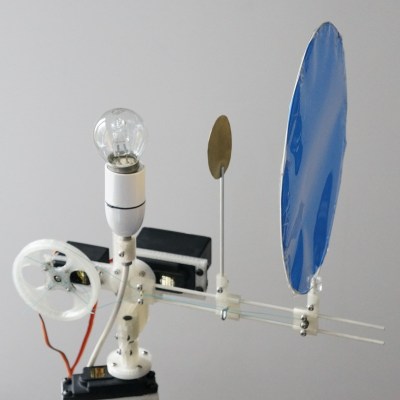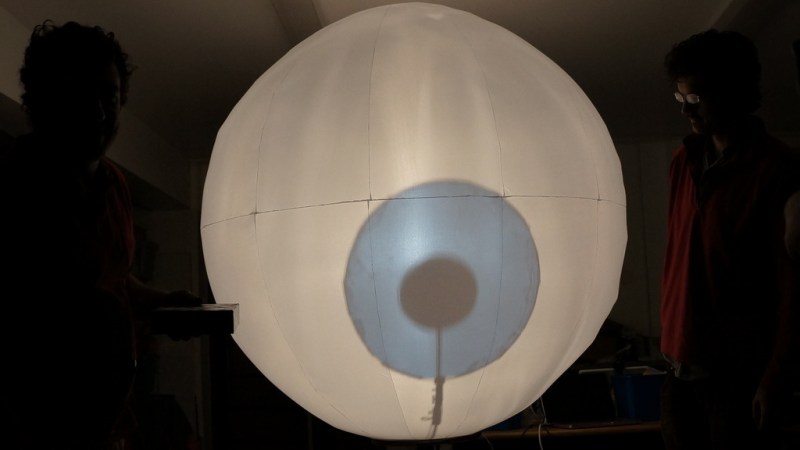 This is an older project, but the electromechanical solution used to create this giant, staring eyeball is worth a peek. [Richard] and [Anton] needed a big, unblinking eyeball that could look in any direction and their solution even provides an adjustable pupil and iris size. Making the pupil dilate or contract on demand is a really nice feature, as well.
This is an older project, but the electromechanical solution used to create this giant, staring eyeball is worth a peek. [Richard] and [Anton] needed a big, unblinking eyeball that could look in any direction and their solution even provides an adjustable pupil and iris size. Making the pupil dilate or contract on demand is a really nice feature, as well.
The huge fabric sphere is lit from the inside with a light bulb at the center, and the iris and pupil mechanism orbit the bulb like parts of an orrery. By keeping the bulb in the center and orbiting the blue gel (for the iris) and the opaque disk (for the pupil) around the bulb, the eye can appear to gaze in different directions. By adjusting the distance of the disks from the bulb, the size of the iris and pupil can be changed.
A camera system picks out objects (like people) and directs the eye to gaze at them. The system is clever, but the implementation is not perfect. As you can see in the short video embedded below, detection of a person walking by lags badly. Also, there are oscillations present in the motion of the iris and pupil. Still, as a mechanism it’s a beauty.
In the video you can see the eye lag behind detecting the person, but you can also see the iris and pupil appear to bounce as they move. This can happen if the motors are too weak or the load is awkward; the motors end up constantly overshooting then overcorrecting as they struggle to move a load that is too heavy or poorly balanced for them. Slow and steady movement is probably fine, but faster and bigger movements will oscillate more.
We recently saw another eyeball project from [Richard] with his flipping eyeball broach, which is like a really stylish 1×1 flip-dot display. And if you happen to detest eyes for some reason, you’re probably interested in this robot whose entire purpose is to find eyeballs, then shine a laser into them.















While the mechanical implementation is interesting, this is a thousand times better:
https://imgur.com/gallery/0lYg7
I want to play an arcade which uses that as a display. Wow.
Wow, the image on those looks nice. Apparently they’re shaped like oversized lightbulbs, I found one of many videos that give a pretty good overview: https://www.youtube.com/watch?v=kcG9O6S6cOU
Those are indeed lovely, but they are also a thousand times smaller. I’d love to do a giant projector-based eye, but I can’t find a way to do it for cheap.
There are these little yellow led projectors for sale on wish for 3 dollars, they have roughly like a 300×500 res and I think only ouput 900 lumens.
The bright side:
Theyre incredible cheap
Shipping is 2 dollars
I can send you a 50% off coupon so you can basically buy one get one for $4 plus taxs if applicable
Thanks, sounds interesting, though I think brightness would be a fatal problem for this. Do you have a link ?
I wonder if it’s possible do to real time video streaming on this. I’d love to play pong on this
With four projectors and a weather balloon, you can do this: https://twitter.com/mikepea/status/508192858944573440
Needs a clear (PMMA?) rod for the iris part, but other than that, nice work! Possible improvement: if used at night or in a dark room, “blinking” could just be flickering the light off for a few milliseconds every few (random) seconds.
Ta! Clear rod is a promising-sounding idea, but it is hard not to get some refraction and hence some shadowing.
I really want to do a mechanical blink, to get the whole descending-eyelid thing going on, but (predictably) I have not got round to it.
I wonder if you could have an semi-circular accordion style shade that would unfurl in front of the light bulb.
(and when fully unfurled, the light bulb is shut off).
Yes, that would work, though it would leave a visible shadow line at the sides when furled. Btu I don’t think there is any mechanism that would do it without a shadow.
So, at last, I’m going to vent this complaint…
Hackaday on Google+ often uses different photos for the same blog article.
Sometimes the photo chosen for G+ is more descriptive of the actual article and sometimes it is not.
This article in particular, the G+ photo gave me no clue about how the device worked.